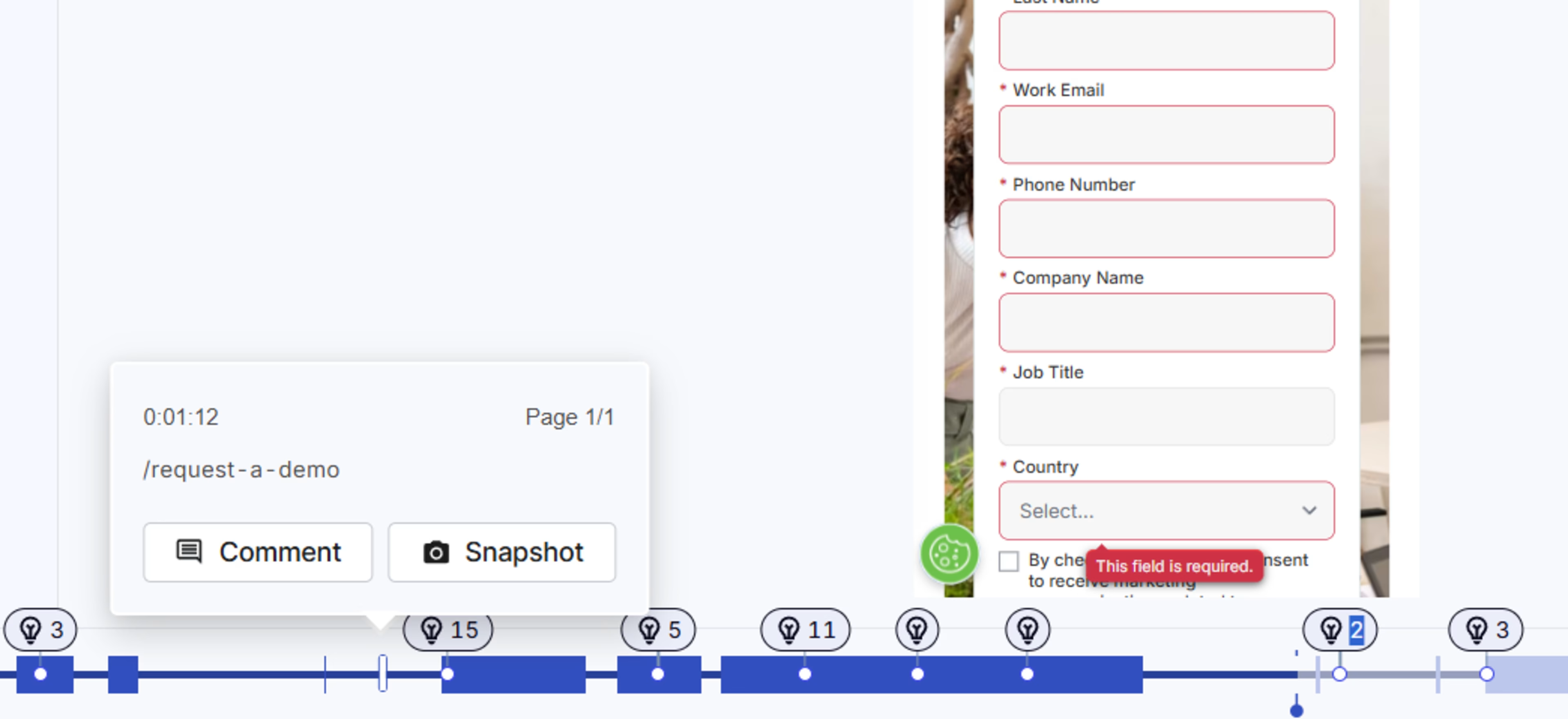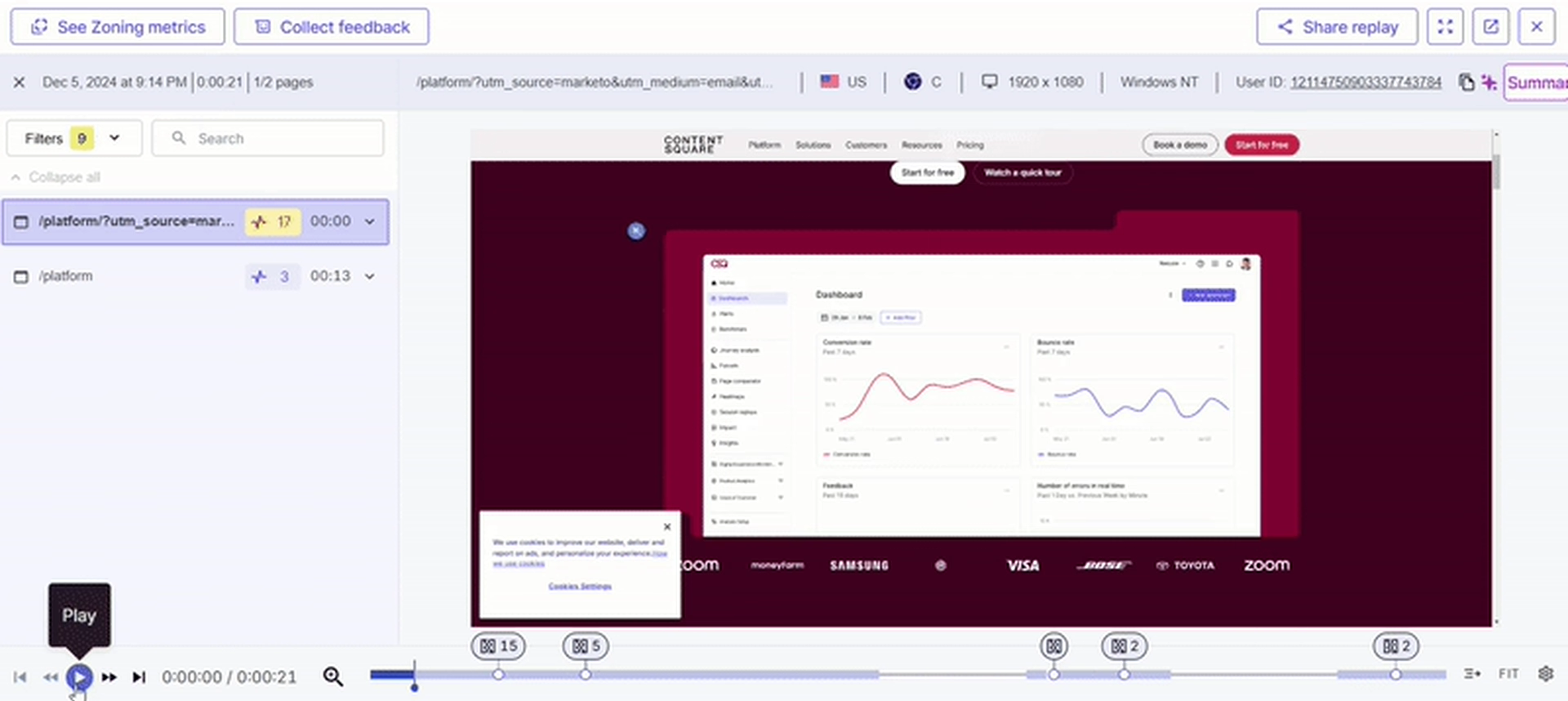Your team has poured their energy into crafting a brand-new website, and you’re just about ready to hit ‘live.’ But how can you be sure your site is truly ready for the spotlight when it hasn’t been tested by real users yet?
Creating a website prototype allows you to see your design through the eyes of real people—giving you the chance to spot and fix issues before launch. It’s your secret weapon to ensure a seamless, user-friendly experience from day one.
The challenge with prototypes is that unbiased feedback also uncovers unexpected problems. So when it comes to testing your prototype, you need to take a structured approach that leaves you with clear, actionable insights. This article explores how to do it—so let’s dive right in!
6 steps to successfully test your website prototype
An excellent website is carefully created with user needs in mind. To achieve this, UX designers typically take an iterative approach, building in stages rather than jumping to the end product.
A website prototype ensures the finished website meets project goals by uncovering areas for improvement early in the process and providing plenty of time to incorporate stakeholder and user feedback with each iteration.
Here’s how to test your prototype and ensure your site meets the highest possible standards from the get-go.
1. Get clear on what insights you need
At each phase of the design process, it’s important to have clear goals for your prototype testing. You can’t test for everything in one go, so agree on a specific question you need answered for each test.
Try to avoid overly general questions, such as, "Is our website engaging?" or "Does our drop-down menu work?"
Instead, get specific:
Can first-time visitors easily navigate to our product pages?
How quickly can users find our support pages from the drop-down menu?
Can users add a product to the shopping cart without extra guidance?
In the next phases, these goals will determine what kind of prototypes you create, what you ask of test participants, and what data you gather.
2. Create the right prototype for your goals
There are 3 main ‘levels’ of prototypes you can build to get feedback from your users.
Low-fidelity prototypes are visual mock-ups of your website idea. They can be simple hand-drawn sketches or computer-designed wireframes showing more detail.
Low-fidelity UI prototyping is helpful when you want to test:
Your site's information architecture hierarchy
Page layout
Participants’ initial impressions of how they would navigate the website
Simple testing helps you understand if these design aspects make sense to users. You can also test multiple designs to compare how participants react to them.
![[Visual] This low-fidelity prototype shows how a website might look on mobile](http://images.ctfassets.net/gwbpo1m641r7/3A0WEpgHD4piBkvh57HFHo/401341fcdd2d8628f3ff496877127615/DeWatermark.ai_1742744853145.png?w=1920&q=100&fit=fill&fm=avif)
This low-fidelity prototype shows how a website might look on mobile
High-fidelity prototypes are full-color, interactive designs. They’re still essentially images, but look like a real website and may contain clickable links that allow users to ‘browse’ the prototype.
They’re helpful when you want feedback on
General design direction
Page structure and information architecture (again)
Links and buttons
Website copy and text readability
Graphics and visual elements
Ease of navigation
![[Visual] This high-fidelity prototype shows how the finished website would look on mobile](http://images.ctfassets.net/gwbpo1m641r7/6ElQAwmnjvdhbgBQHXxG4t/a3356d4efc2aeb74dd2581de626f2eef/UI-HiFi-prototype-visual__1_.jpeg?w=1200&q=100&fit=fill&fm=avif)
This high-fidelity prototype shows how the finished website would look on mobile
Native prototypes are coded websites with basic functionality. While they might not have all the features of the planned website yet, these advanced prototypes process data and give users a realistic experience.
Native prototypes are useful near the end of the visual design process, when you’ve already validated early iterations and are preparing to start development.
They’re helpful for
Testing UI components (like menus, pop-ups, and drop-downs)
Determining how live data might affect the user experience
3. Choose the right type of prototype test for your goals
Most of the time, you’ll want participants to complete specific tasks depending on the goals you outlined in step one.
For example:
You want to find out if users can navigate to a key product page from your homepage. In this case, perform a first-click test with a low-fidelity prototype. Simply ask users to navigate to a specific area on your site, then observe what they click on first.
You want to know if your pricing table makes sense to users. In this case, show users a low-fidelity wireframe and assign a task that involves reading pricing information. After the test, interview them to get their feedback about the table.
You want to know if users find your drop-down menu bar intuitive. In this case, use a clickable high-fidelity or native prototype and ask users to navigate to a page linked in the drop-down menu.
💡 Pro tip: you’ll often find it helpful to get direct feedback from users, either by asking them usability testing questions or getting them to ‘think out loud’ during tests. By observing and listening to users, you can understand both how they behave in prototype tests and why they behave this way.
There are a few more options to consider when choosing your prototype test—let’s check them out.
Moderated vs. unmoderated usability testing
Moderated testing is where a team member is present to give the user guidance or ask them questions. It’s suitable when you need in-depth insights into user preferences and behaviors.
Unmoderated testing involves giving the user instructions and leaving them to interact with the prototype without external guidance (while being recorded). You can follow up by interviewing the user after the test—but during the test itself, the user is alone.
In general, unmoderated testing is appropriate when you want to test a very specific question or observe and measure behavior patterns.
In-person testing vs. remote testing
With modern usability testing tools like Contentsquare (👋), conducting tests remotely is incredibly convenient. Since there’s no need for travel or a testing facility, remote testing is significantly more cost-effective than in-person testing.
However, there are still some advantages of in-person testing. For one, many researchers consider the ability to read body language and facial expressions essential for conducting interviews.
What’s more, with in-person interviews comes less concern about sensitive data being leaked. (Plus, researchers don’t have to worry about the participant having IT problems.)
Quantitative vs. qualitative testing
Prototype testing often focuses on gathering qualitative data, such as
User descriptions of how they perceive the prototype
Researchers’ observations as participants navigate a prototype or complete tasks
💡Pro tip: observe your participants with Contentsquare’s Session Replay tool.
Watch a video-like replay of individual journeys participants take through your prototype. You’ll see every click, scroll, and mouse movement (or, every tap, pinch, and scroll on mobile) for a fuller understanding of user behavior.
![[Visual] Experience Analytics - AB Test Session Replay](http://images.ctfassets.net/gwbpo1m641r7/6B0G5JrPHs7GYx3UTU4sm9/dd0a6aa32cad72ad6a6b087dcd21e816/Experience_Analytics_-_AB_Test.png?w=1920&q=100&fit=fill&fm=avif)
Contentsquare’s Session Replay tool in action
You’ll need to gather quantitative data, too. This is particularly appropriate if you’re performing large-scale prototype or beta testing. In this case, quantitative data could include
User journey completion rates
Clicks recorded by heatmap tools
Results from concept tests, where users are asked to select which of two variants they prefer
Results from first-click tests, where a tool records the first place users click after receiving a prompt like, "Where would you click to buy this product?"
🔥 If you’re using Contentsquare
Want to find out which of two design variants your users prefer? Use the free concept testing template with Contentsquare Surveys to get quick feedback on logos, headlines, graphics, and more.
![[Visual] Contentsquare design survey](http://images.ctfassets.net/gwbpo1m641r7/3G4J9iWUdtZN6Zz8EpBoHn/1e70456280dc195e64a400a3d258df19/unnamed__37_.png?w=1080&q=100&fit=fill&fm=avif)
4. Invite the right participants
The participants you recruit will depend on your goals and the stage of development you’re at.
For early testing with low-fidelity prototypes, testing with colleagues or friends—i.e. people not from your target audience—is usually sufficient
For later-stage testing with high-fidelity prototypes, it makes more sense to run tests with participants from your target audience
This is because, in the early stages, you’re more concerned with understanding if the basic structure of your app is intuitive. In later stages, you’re usually testing how well the app meets your audience’s specific needs.
🔥 If you’re using Contentsquare
Recruit participants for prototype testing by using pop-up surveys on your website. Use our ready-made survey template to present willing participants with a link to your prototype.
![[Visual] Recruit prototype testing participants in minutes with Contentsquare’s ready-made template](http://images.ctfassets.net/gwbpo1m641r7/52ULz0XVhTrhx5dIZbopa9/c26004b2bbc0a2d333b0bd3401922b4a/unnamed__38_.png?w=1080&q=100&fit=fill&fm=avif)
Recruit prototype testing participants in minutes with Contentsquare’s ready-made template
5. Run and record your tests
You’ll need to analyze your data later to find insights, so make sure you’re set up for success:
Give clear instructions with helpful context. Ask users to imagine themselves in a relevant scenario, for example: "You’re looking for a last-minute birthday gift for a relative. Your task is to add a printed hoodie to your shopping cart, go to the checkout, and select the express shipping option."
Invite open criticism. When asking for feedback, make it clear there are no wrong answers and that you’re open to criticism.
Record your testing sessions. Video replays of usability test sessions help you analyze usability tests to see the fine details of where users struggle.
💡 Pro tip: find participants faster with Contentsquare.
Contentsquare’s user research tool, Interviews, helps you host, record, and analyze remote user interviews. What’s more, Interviews gives you access to a pool of over 200,000 verified participants to make recruiting testers super simple.
Thanks to its powerful built-in AI, you’ll also get automated transcriptions of each interview so you can easily share time-stamped notes with colleagues.
![[Visual] Contentsquare’s AI-powered Interviews](http://images.ctfassets.net/gwbpo1m641r7/s4wGKXGaPzzlrCv1biL6U/9543214c8b0809dd9535f8427a7d0d65/Untitled.png?w=3840&q=100&fit=fill&fm=avif)
Contentsquare’s Interviews tool does more than just help you conduct user interviews—it also transcribes them
6. Share your findings and implement changes
Identify trends in user behavior and feedback. Make notes of any interesting feedback users gave you, paying particular attention to comments or themes that came up repeatedly.
If you conducted tests using interactive prototypes, rewatch your test recordings and pay close attention to areas where users got lost, confused, or distracted.
(Need help? 👉 Read our guide to usability testing analysis to learn more about interpreting your test data.)
Share your findings in a report. Give your colleagues a summary of your research, results, and proposals for moving forward. Include enough detail so they clearly see the reasons behind your recommendations.
Include links to key data. It’s easier to get buy-in when colleagues can see important data themselves—like interview clips of users explaining where they struggled, or replays of test sessions that show users encountering website bugs.
🔥 If you’re using Contentsquare
When observing session replays of user journeys in Contentsquare, take snapshots to capture the most interesting part of a replay, label it as a success, frustration, or bug, and tag your teammates to take a look for themselves.

Take snapshots of session replays in Contentsquare and share them with your team
How does Contentsquare help with prototype testing?
An experience intelligence platform like Contentsquare is just what you need to take your prototype testing to the next level and get user-centric insights that matter. Find out how below.
📹 1. See how test participants browse your prototypes with Session Replay
One of the best ways to find areas for improvement is to watch users navigating your prototype. With an over-the-shoulder view of their journeys, you see where they struggle, what grabs their interest, and why they get lost.
Simply install Contentsquare on your website to start recording user journeys. You can use it on functional websites or on low-fidelity mock-ups (as long as they’re hosted on your site).

Contentsquare’s Session Replay tool shows you every scroll, mouse movement, and click
Prototype testing often helps us identify discrepancies between how users claim they interact with a product and how they actually use it. For instance, users may request more options, but testing reveals that having too many choices might lead to frustration and confusion. Early testing is, therefore, highly beneficial, and observing user behavior through heatmaps or session recordings can uncover many hidden opportunities to accelerate customer value.
🔥 2. Get an aggregated view of what users click on and engage with Heatmaps
Seeing where users click, scroll, or move uncovers important patterns in behavior. For example, you’ll find out whether they try to navigate through menu items, or via your search bar.
What’s more, it reveals instances of users trying to click non-clickable items—something that can easily cause frustration.
Simply set up Contentsquare Heatmaps to see an aggregated view of where all users clicked across your tests. This is ideal when you’re doing extensive testing with more than 10 users.
💡Pro tip: get faster insights with engagement zones in Contentsquare Heatmaps.
Most heatmap tools show separate heatmaps for clicks, scrolls, and mouse movements. Contentsquare’s engagement zones combine all three to reveal areas users interact with the most, shortening your analysis time.
![[Visual] Engagement zones example](http://images.ctfassets.net/gwbpo1m641r7/50xYWDqBYOR8E1ACJ1VPH2/cbe82053d739cb28866963c4ab228628/Screenshot_2025-03-09_224508__1_.png?w=3840&q=100&fit=fill&fm=avif)
Engagement zones reveal the most engaging parts of the page
🎤 3. Learn more from your users with Interviews
User interviews can be the most insightful part of your prototype testing. However, organizing interviews is a time commitment—not to mention the fiddly admin of recording calls and sharing files.
Contentsquare’s Interviews tool allows you to automate these processes, from recruiting candidates to hosting, recording, and transcribing calls. Its advanced playback features make it easy to analyze calls and share notes with colleagues, so you can act on your learnings.
![[Visual] Conduct user interviews with Contentsquare’s Interviews tool for easy prototype testing](http://images.ctfassets.net/gwbpo1m641r7/6If1EajvOUuVoqlzxJuhkK/ef53ff8129ffcbb6624da017339d6836/unnamed__39_.png?w=1080&q=100&fit=fill&fm=avif)
Conduct user interviews with Contentsquare’s Interviews tool for easy prototype testing
🧪 4. Validate your assumptions early with User Tests
Running early tests with real users helps you spot friction before you commit to code. Contentsquare’s User Tests tool makes it easy to collect in-the-moment feedback.
Whether you're working with a prototype or a live website, this tool helps you gauge reactions and understand user intent—before it’s too late (or expensive) to change.
Launch unmoderated tests with users anywhere in the world and watch how they interact with your designs—complete with audio and screen replay for richer context. Because it’s part of Contentsquare’s all-in-one platform, you can layer your findings with Heatmaps, Session Replay, and Surveys for a complete picture of what users do and why.
![[Visual] User tests dashboard](http://images.ctfassets.net/gwbpo1m641r7/sqwAOl693ETZdIkhDvSVo/83e366a323fa2b5c160a2f87f5516626/01-Masthead__1_.png?w=3840&q=100&fit=fill&fm=avif)
Contentsquare’s User Tests tool in action
What are the benefits of website prototype testing?
While the benefits may vary according to your development stage, prototype testing improves your overall development process in several ways. Here are 6 of them:
Visualize the final product: a prototype provides stakeholders with a tangible representation of the final product, allowing them to visualize the design, layout, and functionality
Get buy-in for the next stages of development: a prototype helps generate support and investment for the project by presenting stakeholders with the product vision
Test assumptions: testing your prototype enables you to identify any assumptions about the product and adjust your design accordingly, ensuring the final product meets your users’ needs
Identify bugs and UX issues: by conducting usability testing on interactive prototypes, you discover bugs and UX issues users might encounter when exploring the website
Save time and money: resolving problems after the product has been launched is often difficult and costly. Website prototypes help you fix them at a stage where there’s less work to undo.
Find other opportunities for improvement: even if your website designs are free of issues, user feedback could generate ideas for new features or user flows you hadn’t previously considered
Join the dots between user actions and sentiments to build a better website
When you’re creating a website, you can’t afford to rely on assumptions about how users will respond. Prototype testing gives you vital feedback from real people, so you can ensure the finished product meets user needs.
But evaluating your prototype isn’t solely about listening to what users say—it’s about learning from what they do, too. Accordingly, plan your testing to include a combination of interviews and observation, so you can understand what users are doing and why.
With this deeper sense of empathy, you’ll be equipped to create a website that truly delights them.
FAQs about prototype testing

Mohamad Birakdar is a writer, translator, and editor who has contributed to a wide range of online publications and magazines. He enjoys crafting clear, engaging stories that connect with readers across cultures.
![[Visual] [Blog] Prototype](http://images.ctfassets.net/gwbpo1m641r7/1JZk6RypUf7s8huDo3EGgu/3556d38d36806228a8a44ae7510ba5fb/Copy_of_AdobeStock_920265101.png?w=3840&q=100&fit=fill&fm=avif)
